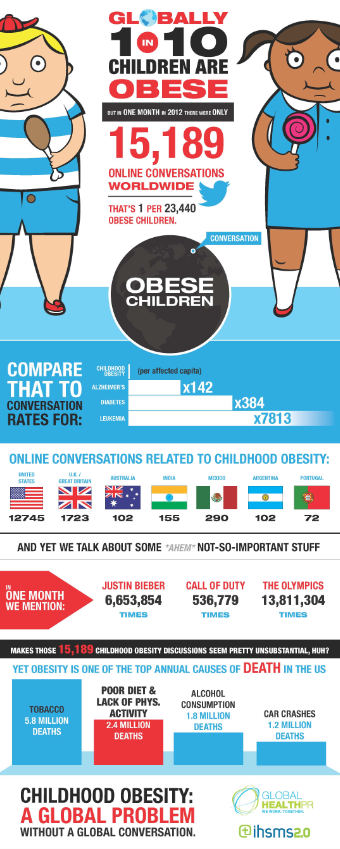Tackling a Weighty Issue: GLOBALHealthPR Alarmed by Childhood Obesity Findings
 The evolution of Health 2.0 in our data-driven world calls for a shift in the way health organizations connect with their target audiences. On a global scale, there is enormous potential to make an impact through digital communications tool and technologies. Before making a change, however, it is necessary to understand who is saying what, and where the conversations – or lack thereof – are happening.
The evolution of Health 2.0 in our data-driven world calls for a shift in the way health organizations connect with their target audiences. On a global scale, there is enormous potential to make an impact through digital communications tool and technologies. Before making a change, however, it is necessary to understand who is saying what, and where the conversations – or lack thereof – are happening.
For our most recent initiative of tracking and scrutinizing online conversations in the spirit of improved public health, we focused on the issue of childhood obesity. In the U.S., experts say 42 percent of people will be obese by 2030. But many people don’t realize this isn’t just an American problem—it’s a problem across the world. Our team collaborated with our partners around the world on an exciting one-month survey of seven countries, looking at how the digital conversation on child obesity stacked up in Argentina, Australia, India, Portugal, the U.K., Mexico and the U.S.
Today, Spectrum and GLOBALHealthPR are thrilled to release an infographic chock-full of the data we found—and what it means for public health professionals, advocates and communicators. Here’s just a taste (pun intended) of our insights (full details can be found here):
- Given that child obesity is a preventable but widespread condition, we were surprised to find that the chatter around prevention and treatment is very low, compared to less common diseases with few or no treatment options.
- For example, leukemia is connected with 7,813 times as many conversations as childhood obesity, despite the fact that leukemia affects fewer people per capita and is not preventable.
- Listening has shown there are enormous opportunities for growth around the childhood obesity conversation. Opportunity begins with simple steps, such as parents, health care providers and school leadership collaborating more closely within online communities, as well as engaging with outside online influencers to spread the word about successful fitness and nutrition initiatives.
Last year, during a first of its kind summit, health communicators within the GLOBALHealthPR network from across the globe convened to present data and reveal insight from a global listening program, which spanned 15 countries, assessing the impact and conversation around malaria, a true global health pandemic. The International Healthcare Social Media Summit team discussed the implications and insights into strategies for using digital tools to benefit national and international healthcare organizations.
The new infographic is available online and can be embedded on other sites with credit to GLOBALHealthPR.
